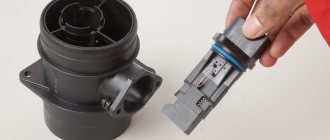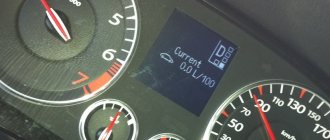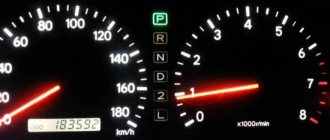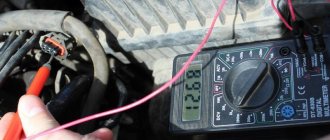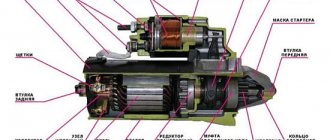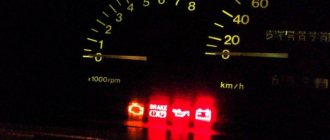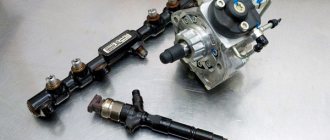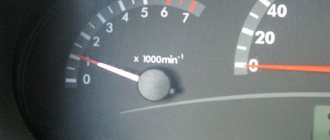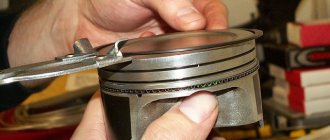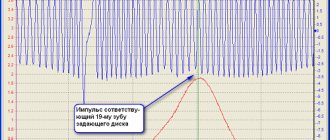Hi all! Not long ago something bad happened. If you let the engine cool down, for example the car sits all night, after starting the engine the revolutions begin to fluctuate. Sometimes the rpm drops to almost 600 and the car tries to stall. While there is no need to help with the gas pedal, the speed evens out on its own.
What could be the reason?
The spark plugs and air filter were changed about 10k kilometers ago. It’s probably time... There is a suspicion of sensors, but which one...
I noticed one more feature. If you turn off the car for a few minutes, then after starting the temperature sensor shows 90 degrees and within 10 seconds drops to 80. If you stop and do not turn off the engine, sometimes the temperature rises to about 85 degrees, but when you start driving it returns to 80. Maybe Is DTOH coming to an end? Could this affect the RPM during a cold start?
List of main reasons
Reasons why idle speed fluctuates
Incorrect operation of the power unit may be caused by a malfunction of certain elements:
- Failure of sensors:
- RXX;
- DMRV;
- DPKV;
- Lambda probe;
- DSA.
- The XX solenoid valve is faulty;
- The air filter is clogged;
- Heavy carbon deposits on candles;
- High-voltage wires are damaged or oxidized;
- Air leak in the intake manifold;
- Incorrect throttle position.
Do-it-yourself troubleshooting
Many faults from the above list can be eliminated yourself in a few minutes. It will take much more time to identify.
Diagnostics of mass air flow sensor and IAC
The mass air flow sensor and idle air control act as regulators of air supply to the combustion chamber.
Failure of these sensors will lead to an increase in fuel consumption, and a broken rod will affect the speedometer needle; it will remain motionless until the problem is fixed.
Diagnosis of DPCV
Crankshaft rotation sensor location
Failure of the crankshaft position sensor will negatively affect the operation of the engine as a whole. A failure in synchronization between the engine and the injection system will result in the car not starting. You can accurately determine the condition of the sensor only by using a multimeter.
To do this you need to do the following:
- Set the position on the sensor with a maximum value of 200mV;
- Connect the multimeter and close the core with a screwdriver;
Checking DPKV with a multimeter
Video about checking the crankshaft rotation sensor
Lambda probe diagnostics
Location of the oxygen sensor (lambda probe)
The sensor reads the amount of oxygen in the exhaust gases and sends a signal to the computer to increase or decrease the air supply to the combustion chamber. Diagnostics is performed with a multimeter on a warm engine. The procedure is as follows:
- One core of the device clings to the ground, the second to the output from the sensor;
- When re-gassing the engine, the multimeter readings should be in the range from 0.2 to 0.9 V;
When checking the lambda probe, the voltage readings should be within 0.2 - 0.9V
Video about checking the lambda probe
Speed sensor diagnostics
The vehicle speed sensor is located in the gearbox. Its diagnosis is carried out by visual inspection of wires and contacts . If oxide is detected, it must be thoroughly cleaned.
Replacing the air filter and glow plugs
Air filter for VAZ-2114
The presence of a large amount of dust on the body and inside the air filter requires its immediate replacement.
Since its throughput is reduced, the engine does not have enough air in the combustion chambers . Due to this, the fuel does not burn completely, and the remaining fuel is thrown out and burns out in the exhaust pipe, which can burn out as a result.
Heavy carbon deposits on the spark plugs or any mechanical damage to the housing require their replacement.
Oil deposits on spark plugs
Important! If the machine was operated with this malfunction, it is recommended to replace the spark plugs, since, due to high fuel consumption, they will be flooded.
Checking wires
The easiest way to diagnose high-voltage wires is in the dark; to do this, just open the hood. If the wire is “broken,” a spark will be visible striking to the side .
Visual inspection of high-voltage wires
Another reason lurking in this place is poor contact, the appearance of oxide. To do this, you need to visually evaluate the wire tips (white, blue or green coating); you need to thoroughly clean them, wash them with Wedge (WD-40), dry them and put them in place.
Healthy! Don't forget about the term "metal fatigue". This refers to the deterioration of current conductivity due to the fact that the contacts are in constant voltage mode. Therefore, high-voltage wires should be periodically replaced with new ones (their specific service life depends on the manufacturer and is indicated on the packaging).
Checking the intake manifold
Most often, air leaks occur through the connection of the intake manifold to the cylinder block .
This happens due to wear of the gasket. This is not difficult to identify. To do this, you will need regular carburetor cleaner. With the engine running, you need to spray the can on all connections and places that cause you suspicion (microcracks in the commutator body itself are also possible).
Does the rpm fluctuate after cleaning the throttle body?
Firstly, an error may have been made during connection. Secondly, calibration is necessary.
The system can be trained manually without special equipment. It consists of unscrewing the negative terminal from the battery for 10 minutes. This will reset the settings to factory settings. When the terminal is returned and the car is started, everything returns to normal. Adaptation algorithm without a PC:
- heat the “heart” of your vehicle and turn it off;
- wait 10 seconds;
- turn on the ignition for 3 seconds;
- press the gas pedal all the way and release it in 1 second, do this 5 times (control yourself with a metronome or stopwatch so as not to lose track);
- wait 7 seconds;
- press the accelerator to the floor and hold it until the check light on the dashboard lights up (first flashes, then stays on);
- wait 3 seconds and release the gas;
- start the unit and check it.
After removing the battery, the speed fluctuates or the engine stalls - we suggest doing the following (on a warmed-up power unit): remove the “-” terminal from the battery and return it after 40 seconds, then set the right pedal at 2100 rpm. (+/- 100) and keep at this level for at least two minutes. If you carry out these manipulations “cold”, then hold in this position for at least ten minutes.
Unstable “heart” activity (the car jerks) of your iron friend when moving is dangerous, so it is important to quickly understand and fix the problem. Sources of failures:
- air filter clogged;
- inoperative remote control position sensor;
- burnt out exhaust valve;
- clogged catalyst;
- failed lambda probe;
- broken spark plugs.
Also, such factors lead to the car being difficult to start.
Video about problems with idle speed on a VAZ-2114, computer diagnostics
Idle instability, especially on a cold engine, can begin in a car from any power system. However, the symptoms and causes differ, since the most characteristic swimming with a clearly defined periodicity is possible only on electronically controlled motors: the period of oscillation is associated with the features of a particular algorithm and the reaction time of the control mechanisms.
Unstable idle speed on carburetor engines
Sudden jumps in speed on cold carburetor engines are “buried” in the carburetor, their causes are purely mechanical. Moreover, they pass after the carburetor is purged, although no malfunctions can be noticed. In fact, the trick lies in the entry of an unnoticeable speck into the carburetor channels: carried away by the flow, it reduces the cross-section of the nozzle, and the composition of the mixture “floats away”, followed by the speed. After some time, the speck shifts due to vibration - the composition of the mixture and the speed are normalized. There cannot be a periodicity of changes in speed here: all moments of change in speed are random.
The second possible reason why the speed of an unheated carburetor engine fluctuates is a leak in the accelerator pump. Under normal conditions, when the throttle is closed, no pressure is created in the accelerator pump chamber and its shut-off valve is closed. If the valve is leaking, the air flow that passes through the carburetor can create a vacuum. It is enough for gasoline to start dripping into the first chamber from the nozzle of the accelerator pump. Each such drop enriches the fuel mixture, and the idle speed jumps slightly.
If the revolutions fluctuate with sufficient amplitude, but slowly, the reason lies in the supply of fuel to the float chamber - the level drops and the mixture becomes leaner. The engine picks up speed on a lean mixture, then they smoothly return to normal. Reasons: jamming of the shut-off needle and float in the carburetor or insufficient pressure developed by the fuel pump at low speeds. In the first case, the fuel pressure at low speeds is unable to push through a needle stuck in the closed position, and after a jump in speed, the rising pressure becomes able to normally fill the float chamber. In the second case, at idle, the float chamber is not filled enough, after raising the speed, the level in it normalizes, and the speed drops - a cyclic change in the fuel level and speed begins.
Checking the flow meter and XX regulator
The speed fluctuates on a cold engine, which means we start the diagnosis by checking the mass air flow sensor. The reasons indicating its malfunction immediately make themselves felt: floating operation of a cold engine and its interruptions, the engine is very difficult to start or does not start at all, as well as significant excess fuel consumption. In order to verify that the sensor is faulty, we will use a tester. The working sensor will show a value of about 1 V. Otherwise, it will need to be replaced.
One of the main reasons causing the engine to float is a breakdown of the engine idle control. This regulator is capable of reducing, or vice versa, increasing the amount of fuel supplied, which is regulated by the operation of a rod with a special needle. To the main faults
regulators include:
Power drop
, or rather, engine speed, can be observed during the operation of some consumers, for example, headlights. If these signs are present, the regulator must be replaced.
Idle instability on cars with a “mechanical” flow meter
In older fuel injection systems, the mass fuel flow sensor was a flap installed in the cross-section of the intake manifold and connected to a contact potentiometer through a lever. The greater the air volume, the more the mass air flow sensor flap deflected.
Over time, the moving contact of the potentiometer wipes the contact track on the potentiometer board, and this happens in the area corresponding to the air flow at idle. As a result, when the motor is running, sharp voltage surges occur at the output of the mass air flow sensor. As soon as the contact slips onto the worn area of the track, the voltage drops (as if the air flow has dropped sharply), the injection system accordingly reduces the fuel supply, and the speed drops. Accordingly, the mass air flow sensor flap moves, the potentiometer contact moves to a whole place on the track - the signal increases, the injection system again increases the fuel supply, the mass air flow sensor again moves the sensor contact to the wiped section of the track... A cyclic floating of revolutions begins, which can only be eliminated by replacing the mass air flow sensor or modifying its board (the board is slightly is shifted in the housing so that the contact moves to the unworn radius of the contact track).
Engine speed fluctuates: symptoms and main causes
First of all, the tachometer helps to notice floating speed. Most often, the floating speed appears at idle. Normally, even on a slightly warmed-up engine, the tachometer needle should remain stable at about 800 rpm while idling.
The only exception is the warm-up speed XX, when the ECU on injection engines itself raises the speed to 1000-1100 rpm. In this case, after the engine temperature rises slightly, the control unit will lower the idle speed to the desired level of 750-800 rpm.
If engine malfunctions occur, then the tachometer needle may drop significantly, then rise again (the speed jumps, for example, from 500 rpm to 800 rpm, from 800 to 1500 and then drops again to 500 rpm).
Also, jumps in speed can be observed if you increase the load on the engine (press the brake pedal, turn the steering wheel in a car with hydraulic booster, turn on the air conditioning or climate control, etc.). The revolutions may also fluctuate while driving in transition modes.
In this case, without additional load, the engine can keep the speed stable at idle, but as soon as the load appears, the speed drops, and the engine almost or completely stalls.
By the way, if the car does not have a tachometer, floating speed can be determined by ear by the sound of the engine, since the noise of the internal combustion engine under the same load constantly becomes stronger and weaker, vibrations also change in intensity.
The driver may also notice a significant increase in fuel consumption, the engine response changes when exiting transient modes, jerks and dips may occur during acceleration, etc.
Floating speed on cars with electronic fuel injection
Here, the cause of unstable idle is air leaks into the intake manifold through the joints of the manifold itself (typical of plastic manifolds), vacuum hoses, and so on. When looking for the reasons for the floating speed on an injection engine, you need to start working by eliminating air leaks, spilling “suspicious” places with a carburetor cleaner spray or other liquid. When liquid gets into a leaky area, it acts as a temporary plug, which immediately affects the operation of the motor.
And malfunctions of the throttle position sensor affect the stability of the idle speed, and the source of the problems is the same as for “mechanical” flow meters: abrasion of the potentiometer track. Moreover, engines with a mechanical throttle drive are free from this problem, since at idle it is stationary and the TPS contact does not move.
On engines with an “electromechanical” (the damper drive is a cable, but the idle adjustment is carried out by a built-in servo drive that corrects the position of the damper) and an “electronic” throttle, at idle the throttle constantly moves within small limits, wearing out the TPS contacts. Only chokes with contactless sensors are free from this. The main problem is that such throttles are monoblocks, where replacement of one throttle position sensor is not provided - the throttle assembly has to be replaced.
Something else useful for you:
Diagnostics of TPS VAZ 2110
To diagnose the sensor we need a voltmeter.
- It is necessary to turn on the ignition and check the voltage between the slider contact and the minus with a voltmeter. The voltmeter should read no more than 0.7 V.
- Now you need to turn the plastic sector, thereby completely opening the damper, then measure the voltage again. The device must show at least 4 V.
- Turn off the ignition and disconnect the connector from the sensor. We check the resistance between the slider contact and some terminal.
- Slowly, turning the sector, monitor the voltmeter readings. Make sure that the needle moves smoothly and slowly; if you notice jumps, the throttle position sensor is faulty and must be replaced.
Symptoms of TPS malfunction
- Deterioration of vehicle dynamics
- Floating idle speed
- Jerking during acceleration
- High idle speed, car does not slow down
- The engine may stall at idle
If one or more of these symptoms are detected, the sensor should be checked and diagnosed in the manner described above.
Why do the revs fluctuate on Common Rail diesels?
Diesels were considered not to suffer from floating idle speeds - their fuel system was so simple in principle that “it either worked or it didn’t,” as they say. Is it possible that metal shavings in a worn injection pump with an inductive dispenser could cause something similar, sticking to the electromagnet, and the airing of the lines disrupts the stability of the idle fluid - but this is determined by the presence of bubbles in the return hoses.
The more electronics appeared on diesel engines, the more pronounced this problem became.
But if for gasoline injection engines the main enemy is “extra” air, then for diesel engines it is “extra” exhaust gases entering through a faulty EGR system. The fact is that the regulation of the diesel operating mode is carried out not by throttling the intake, but by changing the fuel supply - at low speeds there is no vacuum in the diesel intake manifold, there is nothing to suck in air from outside.
The second problem with Common Rail diesel engines is leaking injector shut-off valves. At operating pressures of hundreds of bar, even a small leak creates a “trickle” of fuel entering the cylinders beyond the norm calculated by the injection ECU. Trying to establish a given operating mode, the injection system begins to constantly adjust the fuel supply, falling into the same closed cycle as with air leaks on a gasoline injection engine. For some engines (for example, Renova K9K) such symptoms are especially characteristic.
